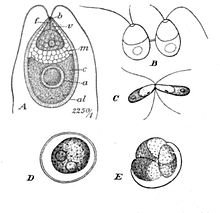
Dunaliella

Dunaliella is a single-celled, photosynthetic green alga, that is characteristic for its ability to outcompete other organisms and thrive in hypersaline environments. It is mostly a marine organism, though there are a few freshwater species that tend to be more rare. It is a genus where certain species can accumulate relatively large amounts of β-carotenoids and glycerol in very harsh growth conditions consisting of high light intensities, high salt concentrations, and limited oxygen and nitrogen levels, yet is still very abundant in lakes and lagoons all around the world . It becomes very complicated to distinguish and interpret species of this genus on simply a morphological and physiological level due to the organism’s lack of cell wall that allows it to have malleability and change shape and its different pigments that allows it to change colours depending on the environmental conditions. Molecular phylogeny analysis has become a critical protocol in discovering the taxonomy of Dunaliella. The genus has been studied for over a hundred years, becoming a critical model organism for studying algal salt adaptation processes. It has remained relevant due to its numerous biotechnological applications, including β-carotenoid cosmetic and food products, medicine, and biofuel research. Dunaliella was originally called Haematococcus salinus by a French botanist named Michel Félix Dunal, who first sighted the organism in 1838 in saltern evaporation ponds in Montpellier, France. However, when the organism was officially described and labelled as a new and distinct genus in 1905 Bucharest, Romania by Emanoil C. Teodoresco, the name was changed to Dunaliella in honour of the original discoverer. To describe the genus, Teodoresco studied live samples from Romanian salt lakes and noted details like colours, movement, and general morphologies. The genus was also described by another biologist in 1905 named Clara Hamburger in Heidelberg, Germany, but unfortunately Teodoresco’s paper was published first while she was in the final stages of her own article’s production. Hamburger’s description was more thorough since she studied material imported from Cagliari Sardinia and was able to study live as well as dead material and could create sections to view inner cell contents and also described different life stages. Since then, various other studies on Dunaliella have been performed. Notable ones include Cavara’s article in 1906 expanding on the Cagliari, Sardinia saltern study by Hamburger, Peirce’s article in 1914 on Dunaliella in the Salton Sea, California, Labbé’s various ecological studies of the algae in salterns of Le Croisic, France, Becking et al.’s studies on Dunaliella organisms from all over the world, and in-depth taxonomic studies by Hamel and Lerche. In 1906, Teodoresco described two species named Dunaliella salina and Dunaliella viridis. The distinct classifications came from D. salina being notably bigger in size and being red in colour due to large amounts of carotenoid pigments. D. viridis was described as smaller as well as green in colour. These descriptions were extensively challenged by other biologists such as Hamburger and Blanchard, who insisted that they were not different species, but simply different life stages with the green cells being the juvenile form . Then, in 1921, Labbé performed a study in which he placed samples of Dunaliella from saltern brines into a lower salinity environment and observed that the organisms adapted to the new conditions of the fresh water and lost their brown-red pigment and became greener – meaning that the red colour must have originated through very euryhaline chlorophyll-filled cells changing to a red colour in extremely saline conditions after permanently damaging their chlorophyll pigments. It is now known that there are actually very few Dunaliella species that can accumulate β-carotenoids and those that do, do so only under high light intensity, high salinity, and limited nutrient growth conditions. Cells then can revert back to a yellow to green colour when environmental conditions become less harsh . Through even more in-depth studies by Lerche et al., we now know that D. viridis is actually a heterogenous group and can be split into different species such as D. minuta, D. parva, D. media, and D. euchlora, though these groups are often grouped into one and called D. viridis. D. salina is now recognized as its own species and will soon become a very important one for biotechnological applications. Things do become more complicated, however, as various molecular studies have been performed on Dunaliella since 1999 to characterize its exact phylogeny. It has become apparent, though hardly confirmed, that there have been many misnamed cultures and synonymous species labelling in the genus that has yet to be worked out through molecular taxonomic research.
